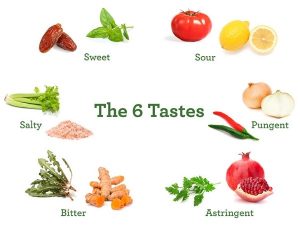Each individual’s taste of food differs; some like pungent food some have a sweet tooth, and some like bland food. I suppose it has a lot to do with our taste buds’ ability to detect different flavors. Although our brains can recognize the six tastes—bitter, sweet, salty, sour, astringent and pungent. The fact is that we do not like all of those tastes. We have special liking for one or two of it.
Role of each taste in our life: Scientists have described different tastes, their primary actions and their common sources. For example, sweet food builds tissues and calms nerves which come from sources such as fruits, grains, natural sugars and milk. Sour food cleanses tissues and increases absorption of minerals. The sources of sour food are sour fruits, yogurt and fermented food. Salty food improves taste of food; it lubricates tissues and stimulates digestion. The sources of salty food are natural salts and sea vegetables. Bitter food detoxifies and lightens tissues and its sources are dark leafy greens, herbs and spices. Pungent food stimulates digestion and metabolism and its sources are pepper, chili, garlic, herbs and spices. Food with astringent taste absorbs water, tightens tissues and helps in melting the fats in body. The best sources of astringent are legumes, raw fruits and vegetables, herbs.
We must try our best to include all six tastes in each meal. Rather than looking at nutritional labels for X amount of protein or Y amount of carbohydrates, the six tastes naturally guide us towards our body’s nutritional needs. Each taste feeds our mind, body, senses, and spirit in its own unique way. They provide our body with nourishing fats and help with blood flow. The brain is made up of 60% fat, so it’s important to consume healthy amounts of good fats each day to keep our brain functioning at its best.
From a modern perspective on nutrition, all six tastes satisfy each of the major dietary building blocks. Sweet foods, for example, are rich in fats, proteins, carbohydrates, and water, whereas Bitter and Astringent foods are high in vitamins and minerals. Our sense of taste also helps us maintain a consistent chemical balance in our body. Liking sugar and salt for example, satisfies our body’s need for carbohydrates and minerals. Similarly, eating sour foods such as oranges and lemons supplies your body with essential vitamins.
Taste buds: our mouth contains around 10,000 taste buds, most of which are located on and around the tiny bumps on our tongue. Every taste bud detects five primary tastes i.e sour, sweet, bitter, salty and pungent. Japanese have invented Umami salts of certain acids such as monosodium glutamate or MSG. According to the official Umami Information Center, “umami is a pleasant savory taste imparted by glutamate, a type of amino acid, which occur naturally in many foods including meat, fish, vegetables and dairy products.
Each of your taste buds contains 50-100 specialized receptor cells. Sticking out of every single one of these receptor cells is a tiny taste hair that checks out the food chemicals in your saliva. When these taste hairs are stimulated, they send nerve impulses to your brain. Each taste hair responds best to one of the five basic tastes.
Tastes and flavors: If you have a cold, the lining of your nose swells and you temporarily lose your sense of smell. Even though your tongue is still able to identify the basic tastes, the food you eat will taste bland. Additionally, temperature and texture influence how much you appreciate foods. When you eat ‘hot’ foods like chilli peppers, you actually excite the pain receptors in your mouth. The brain sends the body signals when it requires energy in the form of food. By incorporating all six tastes into each meal, we ensure that these signals are adequately met, thus avoiding food cravings or the over-consumption of certain foods.
Including the six tastes in each meal does not need to be a frightening task. Adding a squeeze of lemon to cooked dishes, for example, can quickly satisfy the sour taste, while adding a side salad will fulfill the bitter and astringent tastes.
Each person’s body constitution is unique: which is why, it determines the proportion of tastes you eat. The body naturally desires tastes that balance its doshic makeup as per the Ayurveda. It automatically shuns tastes of an aggravating nature. In this sense, the body works naturally for us; if we simply follow our natural inclinations, we are led to the proper foods. Vata individuals, for example, are naturally drawn to moist, grounding foods, while Kapha individuals favor light, drying foods. Ayurvedic nutrition recommends including all six tastes in each meal. While favoring those tastes that bring greater balance to your particular constitution. A Pitta individual, for example, will favor cooling foods and spices such as dark leafy greens and fennel,which are high in Bitter and Astringent tastes, while requiring a smaller quantity of the Pungent taste.
The average person needs to eat about 2,000 calories every day to maintain their weight. However, a person’s specific daily calorie intake can vary depending on their age, health condition, gender, and physical activity level. Men generally need more calories than women, and people who exercise need more calories than people who don’t. Different flavors balance and counter balance each other, therefore, try and include all tastes in your daily food.













































